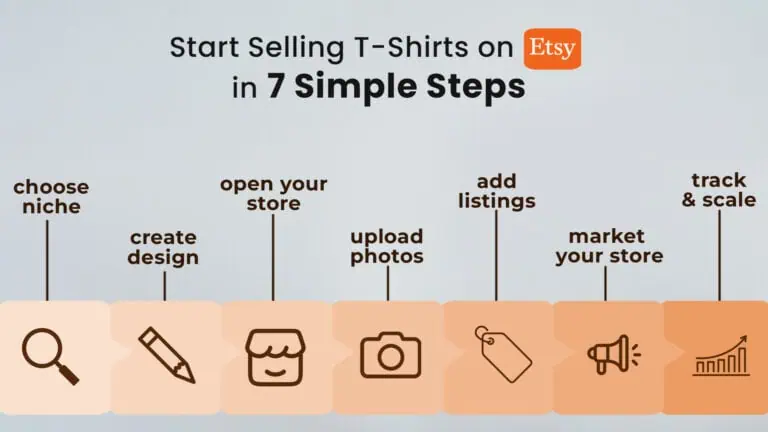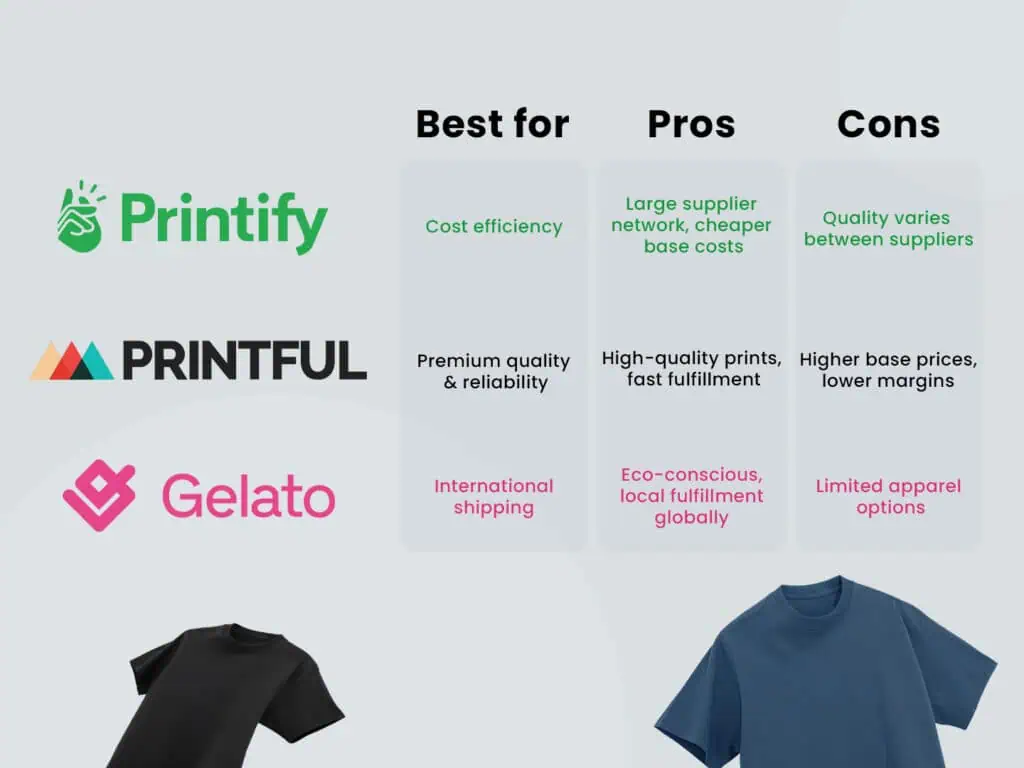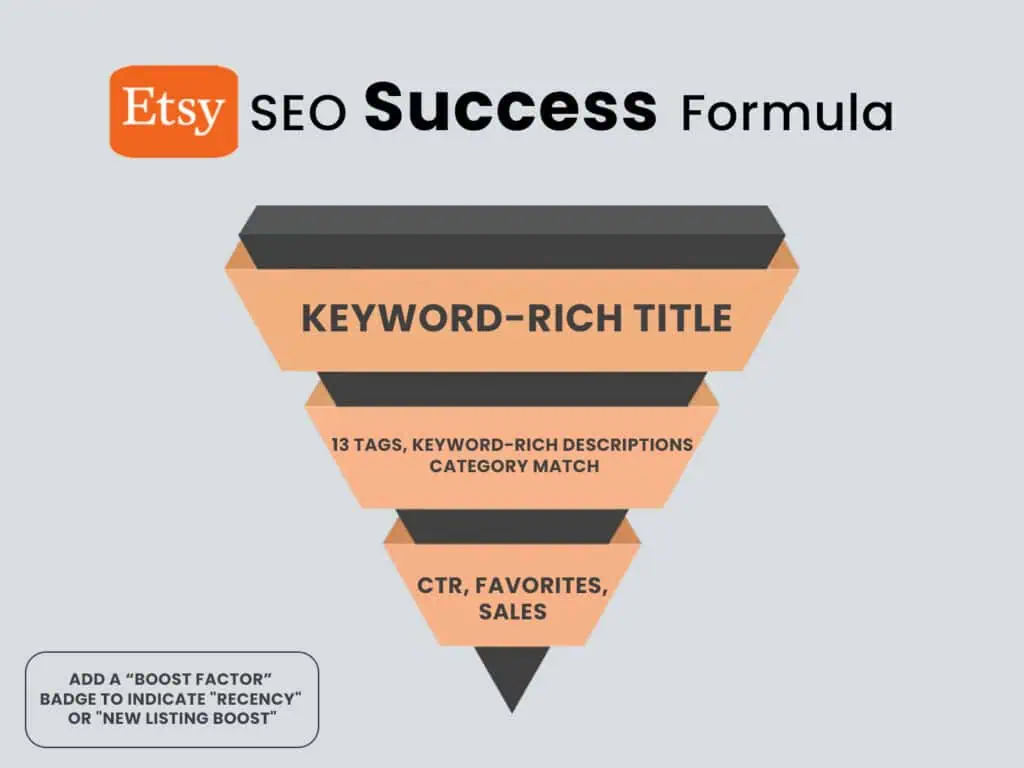

Starting a business is intimidating. But Etsy makes it feel doable, especially if you’re just getting your feet wet. It’s one of the few places where you can test an idea, sell your designs, and grow a customer base without needing to rent a space or sink money into inventory. That alone makes it worth considering.
What really makes Etsy work is that it already brings in buyers who are actively looking for something different. They’re not hunting for mass-produced tees.
You also don’t need printing equipment, shipping materials, or even storage space. Platforms like Printify, Printful, and Gelato make it easy to sell on demand. That means you design the shirt, list it on Etsy, and when someone buys it, your partner prints and ships it for you. Simple as that.
Add 50 + products to Etsy Tonight! Start Selling Tomorrow
Etsy remains one of the first platform choices for launching a t-shirt business in 2025.
What sets Etsy apart is its customer base: people come to Etsy looking for personalized, niche, or handcrafted items. This aligns perfectly with the t-shirt market, where design themes, messaging, and aesthetic choices are deeply personal.
Unlike platforms like Amazon or eBay, Etsy buyers actively look for originality. It means even if you’re a beginner, your t-shirt designs have a chance to stand out.
Etsy’s integration with print-on-demand (POD) services like Printful and Printify makes launching a t-shirt business possible without any inventory, shipping, or upfront investment in bulk printing.
As YouTuber Handmade Bosses puts it:
“If you’re selling t-shirts, Etsy gives you a huge advantage because people are already browsing with a credit card ready. All you have to do is show up with the right design for the right audience.”
Success on Etsy begins with choosing a clear and focused niche. Instead of selling t-shirts online to “everyone,” define who you’re targeting.
Niches like pet lovers, mental health advocates, fitness enthusiasts, or spiritual humor perform well because they resonate deeply with their audience.
Use Etsy’s search bar to validate niche ideas. Start typing phrases like “funny gym shirt” or “cat mom shirt” and look at what auto-fills—those are real search terms with buyer demand.
You can also use keyword tools like eRank, Everbee, or Marmalead to dig deeper. These tools show how often a keyword is searched, how competitive it is, and even how much revenue top listings are generating.
Combine this information with browsing top-performing shops in your niche to identify gaps you can fill with your own spin.
You don’t need a design degree to create t-shirts that sell. Tools like Canva, Kittl, and Adobe Express make it easy to design clean, market-ready graphics with zero design experience.
Clever, typography-based designs are some of the top-selling shirts on Etsy. Think short, punchy quotes or relatable one-liners in attractive fonts. Humor, sarcasm, and empowerment are consistent winners when combined with easy-to-read text and good layout.
As explained by YouTuber TshirtSideHustle:
“You don’t need complicated designs. Some of my bestsellers are just two words in bold font. Simplicity sells—especially if it’s funny or highly relatable.”
However, you must avoid the trap of using copyrighted or trademarked content. That includes phrases from TV shows, brands, movies, or celebrities. Etsy is quick to take down listings that violate IP rules, and repeat offenses can get your shop permanently banned.
On Reddit, one user warned:
“Taylor Swift trademarked Shake It Off after her song and then sent a slew of item removals to Etsy sellers over their products with the phrase on it.”
Stick to original designs or use platforms like Creative Fabrica or Vexels, which offer commercial-use templates and fonts. Always double-check licensing terms.
From handling printing and shipping to returns, a POD partner is integral to your Etsy t-shirt business. So, choosing the right one affects everything from your product quality to profit margins. Here’s how the top providers compare:

| Platform | Best For | Pros | Cons |
| Printify | Cost efficiency | Large supplier network, cheaper base costs | Quality varies between suppliers |
| Printful | Premium quality & reliability | High-quality prints, fast fulfillment | Higher base prices, lower margins |
| Gelato | International shipping | Eco-conscious, local fulfillment globally | Limited apparel options |
YouTuber Wholesale Ted explains:
“Printify gives you better margins, but you need to test the supplier. Printful gives you peace of mind—it just works.”
Look for direct Etsy integration, automated order sync, white-label packaging, and consistent print standards. And before launching, order samples to experience what your buyers will receive.
Your shop is your storefront. First impressions matter, so invest time in branding it correctly.
Choose a name that fits your niche and is easy to remember when selling shirts on Etsy. Create a clean logo and shop banner using Canva or hire a designer on Fiverr for a polished, cohesive look. Your brand should reflect the style and tone of your target audience.
Before launching, create at least 10 listings. This gives Etsy’s algorithm more data to understand your shop and increases your visibility across different search terms.
Your listings must follow Etsy SEO best practices. Start with strong, keyword-rich titles. Use natural language, but front-load important terms, such as Funny Nurse Shirt, ER Humor Tee, and Gift for Healthcare Worker.
Use all 13 tags per listing, mixing short and long-tail keywords. Your description should include relevant keywords, explain the shirt’s purpose, who it’s for, what it’s made of, and what makes it special.
On Reddit’s Etsy community, several sellers say
“The median contribution from Etsy’s search algorithm appears to be around 58-60% of total shop traffic.”
Pricing your shirts correctly can be tricky. Too low, and you cut into your profits. Too high, and you scare away buyers.
Start by calculating your base cost (POD price + shipping + Etsy fees). Etsy takes 6.5% of the listing price plus a $0.20 listing fee and payment processing fees (~3%).
Let’s say your shirt costs $10 to print and $4 to ship. Etsy takes another $2. That’s $16 in cost. You’d need to sell at $23–$25 to earn a decent profit.
Reddit users usually recommend:
“Aim for a minimum of $7–$10 profit per shirt to make it worth your time.”
Bundle shipping with the product price and offer “free shipping” to appeal to Etsy’s algorithm. Consider offering tiered pricing or release discounts for repeat buyers.
You can use competitors in your niche as pricing benchmarks, but don’t feel pressured to undercut if your branding and quality justify premium pricing.
Etsy prioritizes listings based on relevance, conversion rate, customer feedback, and listing quality. The more aligned your listings are with what people are actively searching for—and the more they convert—the more visibility you’ll get in search results.
Here’s what Etsy considers:
YouTuber Nancy Badillo explains:
“You don’t just want traffic—you want qualified traffic. Etsy tracks what gets clicks, what gets added to cart, and what gets purchased. That’s how it ranks your listings over time.”
Etsy Ads, on the other hand, work independently from organic search. You pay to appear in sponsored placements. While ads can boost visibility, they don’t improve your organic ranking unless they convert well.

Finding the right keywords is essential for Etsy SEO. Thankfully, several powerful tools help identify what terms buyers are searching for—and which ones you can actually compete on.
When building your listings, use long-tail keywords wherever possible. These are more specific phrases like “funny introvert shirt for women” instead of generic ones like “funny t-shirt.” Long-tail keywords have lower competition and tend to convert better.
Plus, listings with keyword consistency across titles, descriptions, and tags tend to rank better. So, keep a spreadsheet of your winning keywords so you can reuse and scale them across future listings.
Relying solely on Etsy’s internal traffic is risky, especially in a competitive category like t-shirts. Building outside traffic sources can give your listings an edge, helping grow your brand beyond the platform.
Pinterest is one of the best long-term drivers of traffic on Etsy. It’s a visual search engine, which makes it perfect for t-shirts.
Create vertical pins using mockups, and write keyword-rich pin titles and descriptions. Use tools like Tailwind to automate posting and schedule seasonal content.
Etsy seller Samanthanco on Reddit mentions:
“From a business standpoint point Pinterest can really boost your shop. My shop has literally seen 150% more sales in 3-4 weeks.”
TikTok and Instagram Reels are other powerful platforms for viral exposure. Short-form videos showcasing your design, relatable humor, or niche-specific content can grab attention quickly.
Another user backs this up on the Etsy subreddit:
“A friend of mine gets most of her sales from TikTok, but she’s very authentic with her videos.”
In summary:
Etsy Ads can be useful—but only if used carefully. Most new sellers make the mistake of running ads on unproven listings and end up burning through their budget with little return.
A smarter approach is to:
You can succeed with Etsy ads, but it takes several months.
Etsy provides a performance dashboard that helps you track which listings are being clicked and which ones are converting. Turn off ads on poor performers, and double down on designs that show a strong cost-per-sale ratio.
A Reddit user shares:
“They monitor the performance and turn off ads for listings that are not making a return, ensuring that their budget is used effectively.”
Bottom line? Ads work, but only if your listing already performs well organically.
Once a customer places an order, your print-on-demand partner kicks in. To avoid errors, ensure syncing your POD platform fully with Etsy.
Platforms like Printify and Printful offer automatic syncing. When an order is placed, it’s auto-routed to production, fulfilled, and shipped without manual input. But things can go wrong if settings are misconfigured.
Common issues include:
On Reddit, Etsy sellers strongly recommend syncing all inventory and shipping settings upfront. However, manually fulfilling orders creates room for error.
You can minimize risks by:
Returns are rare in POD t-shirt businesses, but complaints usually happen around sizing, delayed shipping, or print quality. Having clear and fair policies protects you and sets buyer expectations.
Tips for managing customer issues:
Reddit’s r/EtsySellers subreddit is filled with advice like:
“Replacing a shirt quickly gets you a 5-star review and avoids a case.”
So, make your return and refund policy visible in each listing. Be upfront about sizing charts and POD fulfillment times to avoid misunderstandings. Etsy favors sellers with good response times and high ratings, so clear communication helps both your reputation and visibility.
Many Etsy sellers eventually look to Shopify to gain full control over branding, email marketing, and repeat customers. Etsy is great for discovery, but it’s risky to build your entire business on a platform you don’t own in the long term.
As YouTuber Wholesale Ted explains:
“Etsy is a rented space. Shopify is owned real estate. Most sellers use both—Etsy brings in new buyers, and Shopify turns them into repeat customers.”
Here’s when to consider Shopify:
An Etsy seller echoes this approach on Reddit:
“Shopify is great, definitely worth it both to create your own website and link all your online stores. You can also import all your current listings from etsy onto shopify which will save you A LOT of base work.”
You can use apps like Mailchimp or Klaviyo to capture emails, create popups, and launch email campaigns. Or use Linktree to connect both platforms on your social profiles.
As your business grows, you may want to outsource t-shirt design work or scale faster using commercial-use templates.
YouTuber Cassiy Johnson shares:
“I use Creative Fabrica to speed up design time. I combine their fonts and elements with my own ideas—makes 10x the content in half the time.”
Your designing options include:
Just make sure to double-check each platform’s license, as not all assets are cleared for POD use, especially with no modifications.
Even with the best intentions, many beginners fall into avoidable traps that stall their progress or even lead to account suspensions. Learning from others’ mistakes is the fastest way to avoid unnecessary setbacks.
Copying competitors instead of validating market fit is one of the most common errors. It’s tempting to see what’s selling and mimic it. But without understanding your audience, the copied design often flops.
YouTuber Stan Banks advices on his channel:
“You can’t just copy a bestseller and expect results. It’s not just the shirt—it’s the niche, branding, SEO, and timing. Copy the strategy, not the product.”
Not testing different mockup styles is another big one. If you only use flat-lay images from your POD provider, you’re missing a major opportunity to stand out. Using the best mockup generators to create lifestyle mockups helps buyers imagine themselves in your product, which directly improves conversion.
To scale your visuals without spending hours manually editing, sellers often recommend tools like BulkMockup.
“This is the best software if you are a person who needs to make mockups. It has cut my time down to 1/10 of what it was.”
Also, using low-quality shirts to save money is a short-term win but a long-term loss. Cheaper shirts lead to shrinkage, fading prints, and bad reviews. Consistent 5-star reviews compound into Etsy’s algorithm, which improves your ranking and visibility over time. So, prioritize quality even if it reduces your initial margin.
Next, ignoring international shipping limits your reach. Etsy’s global marketplace has strong audiences in Canada, the UK, Australia, and Europe. POD services like Gelato or Printify can fulfill orders closer to the customer, reducing shipping times and costs.
Real stories of success offer both guidance and inspiration. While results vary, most sellers who stick with it and treat Etsy like a real business start seeing consistent sales within 3 to 6 months.
A common milestone is the first sale, often celebrated as a major breakthrough. Then comes the first 100 sales, the bestseller badge, and finally, Etsy’s Star Seller badge for top-performing shops.
To earn the Star Seller badge, you need to maintain
Reddit is full of similar breakthroughs. For example, Lissy730879 says on the Reddit thread:
In my own experience, I started in April 2022. Last year was my first full calendar year doing this, and my revenue was $297,000. My profit is about 20%. This year, I am on track to double that.”
These sellers consistently mention:
The realistic timeline for success is not overnight. Rather, it depends on 10 to 15 solid designs, a clear brand, and consistent updates. Remember, Etsy rewards you with compounding visibility.
Starting a profitable t-shirt business on Etsy in 2025 is more accessible than ever—but only if you approach it with strategy, patience, and the right tools.
Here’s a quick recap of your step-by-step blueprint:
Remember, tools like BulkMockup can save you dozens of hours when scaling listings. And don’t underestimate the power of 5-star reviews, great mockups, and niche relevance.
Now it’s your turn.
If you’ve been sitting on ideas, this is the sign to start. Open that Etsy shop, upload your first listings, and tweak as you learn. Bookmark this guide for future reference, and return to it as you hit new stages.
There’s never been a better time to start.
Build more listings. Make more Sales
Yes, Etsy had a total of 89.6 million active buyers in the fourth quarter of 2024, which gives t-shirt sellers a great opportunity to make profits.
Generally, Etsy policies don’t require t-shirt sellers to have a business license. But you may obtain one to comply with your local business regulations.
Follow these quick tips to run your Etsy t-shirt store successfully:
Select a good-quality fabric material
Use high-definition t-shirt photos and videos
Add SEO-optimized descriptions and titles
Don’t copy designs
Release new designs often
Find the right price point
Promptly reply to customers
Get the Star Seller badge
Regularly analyze store performance
On average, it will take around 3 months to close your first t-shirt sale on the Etsy store.
No, the buyer has to bear the shipping cost for the t-shirt purchase.
Etsy charges 6.5% transaction fees on the total cost of your t-shirt listing.
New Etsy sellers can withdraw funds in 14 to 20 days based on order status, payout schedule, and bank processing times.

